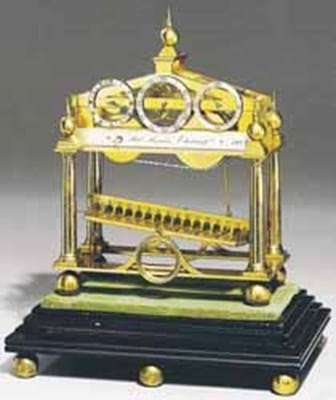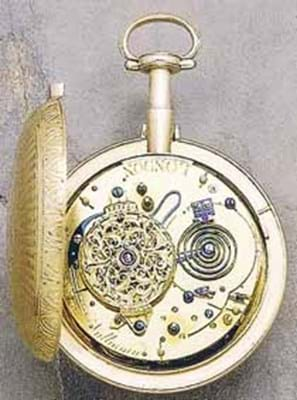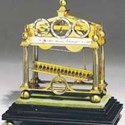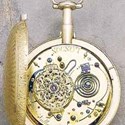Dating to c.1803, it was previously owned by Sir William Gibson-Craig who had bought it from Robert Bryson's son. A letter written in 1877 by an evidently single-minded Sir William states it had taken him 40 years to persuade Bryson Jnr. to sell it to him. The only example of its kind thought to have been made in Scotland, it fetched £40,000.
While clocks, barometers and chronometers were the order of the day for Christie's July horological sales, the auctioneers' attention was focused on watches the month before, with just shy of 400 lots offered by their South Kensington rooms (19.5/12% buyer's premium) on June 23. The wristwatches dominated the sale in terms of content, but some of the more expensive entries failed to find buyers and it was the smaller and earlier pocketwatch selection that provided most of the day's best-sellers.
Topping the bill as predicted at £32,000 was a rare London-made cylinder watch fitted with a sweep centre seconds hands dated to c.1800, signed Jno. Kenebel Frith Street, Soho and numbered 1454. The watch was contained in an attractive gold case bordered with split pearls and enamelled to the cover with a pastoral scene entitled Evening after an engraving by Conte that was particularly well preserved. The price compares with the SFr80,000 (£33,475) paid for an identical watch numbered 1455 sold from the Sandberg collection by Antiquorum in 2001.
But the sale also saw strong prices achieved for some plainer examples that relied principally on good makers and complex horology for their attractions. A case in point was the 15ct gold-cased duplex pocket watch pictured below right, one of four watches entered by an anonymous nobleman, all of which were notable for their particularly crisp condition, said Christie's Oliver Saunders. This example, which was contained in an engine-turned and armorial engraved case, had a movement by the renowned maker Benjamin Vulliamy (fl. 1781-1820), clockmaker to George III. With its sophisticated array of functions including dumb quarter repeat, centre seconds and temperature compensation curb, in Mr Saunder's view this was a "bells and whistles" model and, in addition to its fine condition, came with a period mahogany fitted box. It duly achieved a double-estimate price of £15,500 tendered by a dealer.
From rolling balls to bells and whistles
ANOTHER of the top-priced clocks to feature at Christie’s King Street (19.5/12% buyer's premium) on July 2 was this Regency rolling ball skeleton timepiece pictured right, made in Edinburgh by Robert Bryson after the model by Sir William Congreve, the inventor of the rolling ball clock.








